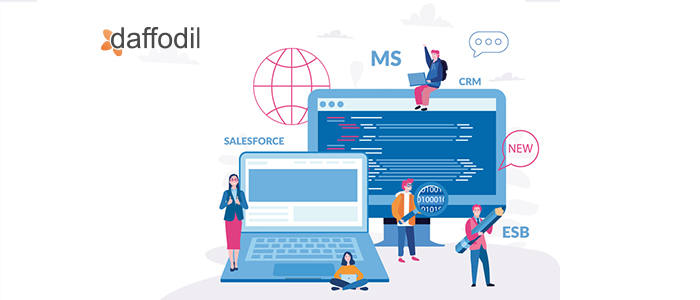
The business landscape of the modern world is heavily customer-centric with marketing, sales, and customer support at the center of operations. Salesforce is the most sought-after Customer Relationship Management (CRM) software intended for these purposes. There are a variety of roles and responsibilities in an enterprise's Salesforce team and the Salesforce Administrator is usually at the helm of it.
The Salesforce Administrator has the responsibility of managing the Salesforce development workflow. So these individuals need to have a special knack for quickly understanding business requirements, seeing where there is a need for fixes, and bridging the gap between what needs to be implemented and what skills the team members possess.
We will look at the various ways that Salesforce Administrators are pivotal in the business workflow of Salesforce dedicated teams building CRM solutions. Also, we will look at their roles and responsibilities on a fundamental level.
What Is A Salesforce Administrator?Organizations leveraging Salesforce CRM for the automation of business workflows rely on business leaders known as Salesforce Administrators to achieve the successful implementation of this automation. Admins also are tasked with educating various stakeholders on the functions of the Salesforce CRM. |
They arrange CRM data, both structured and unstructured, into highly intuitive dashboards, and graphical representations of workflows. They know exactly which Salesforce applications can be directed for the purpose of processing and assimilating this data to derive valuable and actionable insights.
Salesforce Admins guide entire Salesforce teams including Salesforce business analysts, developers, architects, project managers, and so on in understanding how the organization interacts with Salesforce CRM. They possess knowledge about the organization's workflow down to a surgical level.
One of the most critical reasons why enterprises need Salesforce Admins is because they are skilled in utilizing the diverse suite of Salesforce tools at their disposal to eliminate inefficiency and foster productivity. All users of an enterprise Salesforce system leveraging it at different levels can absorb the necessary know-how from administrators.
What Are The Roles And Responsibilities Of A Salesforce Admin?
The tasks of a Salesforce Admin are extremely diverse, ranging from data quality maintenance, modifying data tables, adapting backup data, merging CRM data with enterprise systems, finding productivity solutions, and so on. These roles and responsibilities can be distinguished on the basis of the timeline of their implementation as follows:
Ad hoc Problem Solving
Admins need to be on their toes for ad-hoc requirements wherein users report problems in real-time and seek expedited solutions for the same. These tasks may include but are not limited to the following:
- Two to three hours of exclusive attention to user account calibration of close to a hundred accounts in bulk
- Authentication issues related to two-factor authentication, SSO, and Salesforce certification problems
- Enabling analysts to develop ad-hoc reports and sharpen them so that the insights derived from them translate to significant metrics
- Email workflows related to running campaigns, setting up auto-responses, and automating approval cycles
- Managing rule-based access to records and hiding certain confidential records on a "for your eyes only" basis
- Flattening the learning curve related to campaign budgeting, recognizing record types, information sharing priorities, and so on
Weekly Tasks
There are certain tasks in the Salesforce admin's roster that require a dedicated two to six hours a week to reach a resolution. The tasks that are usually classified as weekly tasks are the following:
- The foremost weekly task is categorizing effort-intensive jobs as weekly, especially those that involve multiple user groups and all-inclusive use-cases
- Taking the weekly snapshot of the CRM data, i.e., carrying out a weekly data export with all necessary attachments and tables containing history
- Duplicating necessary data points using tools such as DemandTools, followed by deduping them when it is past their due usage
- Running all kinds of data-related dashboards such as utility dashboards, data quality dashboards, and adoption dashboards
- Identifying all the jobs that are in the Apex queue, or holding status, and weeding out all the unnecessary data entries
- Weekly mandates such as transferring record ownerships, importing leads, updating prices, deactivating idle users, and running all Apex tests
Customer Success Story: Daffodil enables a European coffee chain to increase the efficiency of their operations by 67%.
Monthly Tasks
About one or two days of the month must be aligned for carrying out certain tasks related to the Salesforce sandbox, the updating of data, and pre-testing:
- Changes in the metadata should be made as occasionally as possible, for which a monthly frequency is said to be adequate. Additionally, these changes must be pre-tested in the sandbox before they go into production to avoid possible conflicts
- Identifying fields in data tables that are leading to data pollution and deprecating those fields that are persistently unpopulated
- A complete backup of the metadata is made before implementing a full refresh of the sandbox, creating new projects, and archiving them
- Lining up the refreshing of the sandboxes with the updates made by each Salesforce developer
- Carrying out the patch installs for high-priority fixes by following a workflow wherein implementing, pre-testing, and fixing happen in that order
Quarterly Tasks
These tasks are mission-critical and every update or change can affect the functions of the enterprise as a whole. So special care must be taken while carrying them out. They include:
- Sifting through the user login database, changing member names, and access in the Communities and Partner Portals, and downloading the respective CSV from the setup audit log
- Any changes in the third-party applications connected to Salesforce will reflect in the upgrade cycles, so associated configurations and operational changes need to be carried out accordingly
- Identifying candidates for consolidation by pinpointing which roles and profiles have no active users in them
- The system's object model must be examined for its health using tools for running tests on all tables
- Pre-release features that need to be tested in the sandbox are reworked to accommodate version changes in the code, special buttons, and formulas
- Attending Salesforce user group meetings and seminars, while not mandatory, is a prominent part of Salesforce admin best practices, for gaining insights into better methods of operation
Annual Tasks
Annual tasks of the Salesforce Administrator consist of capturing and aggregating the data that needs to be archived for regulatory and compliance-related documentation subsequently. These include:
- At the end of the financial year, it is often the Admin's duty to archive all the system's field history tables so that an audit trail for that year is available
- Based on the organization's record retention policies, the Admin either archives or purges all the year's documents, campaign emails, etc. to manage the storage charges for the enterprise system
- Archiving all other essential trackable histories for compliance, as well as regulatory reasons, while creating another annual audit trail
- After summarizing all the Salesforce activities and upgrades of the year, the Admin is free to attend the annual DreamForce seminar
ALSO READ: How Salesforce Customization Services Boost Business Efficiency and Performance
Salesforce Admin Is Responsible For The Quality Of Business Workflows
As the onus of ensuring data quality and streamlining of business processes rests on the Salesforce Admin, they must be proactive in enforcing consistency in the Salesforce team's tasks. Not only are they responsible for highly crucial work, but they are also supposed to adhere to a tight schedule and deadlines.
Enterprise successes in terms of sales, marketing, and customer support are all direct consequences of the tireless efforts of the Salesforce Administrator. To learn how you can enhance the effectiveness and precision of your CRM workflows, you can refer to Daffodil's end-to-end Salesforce Development solutions.



